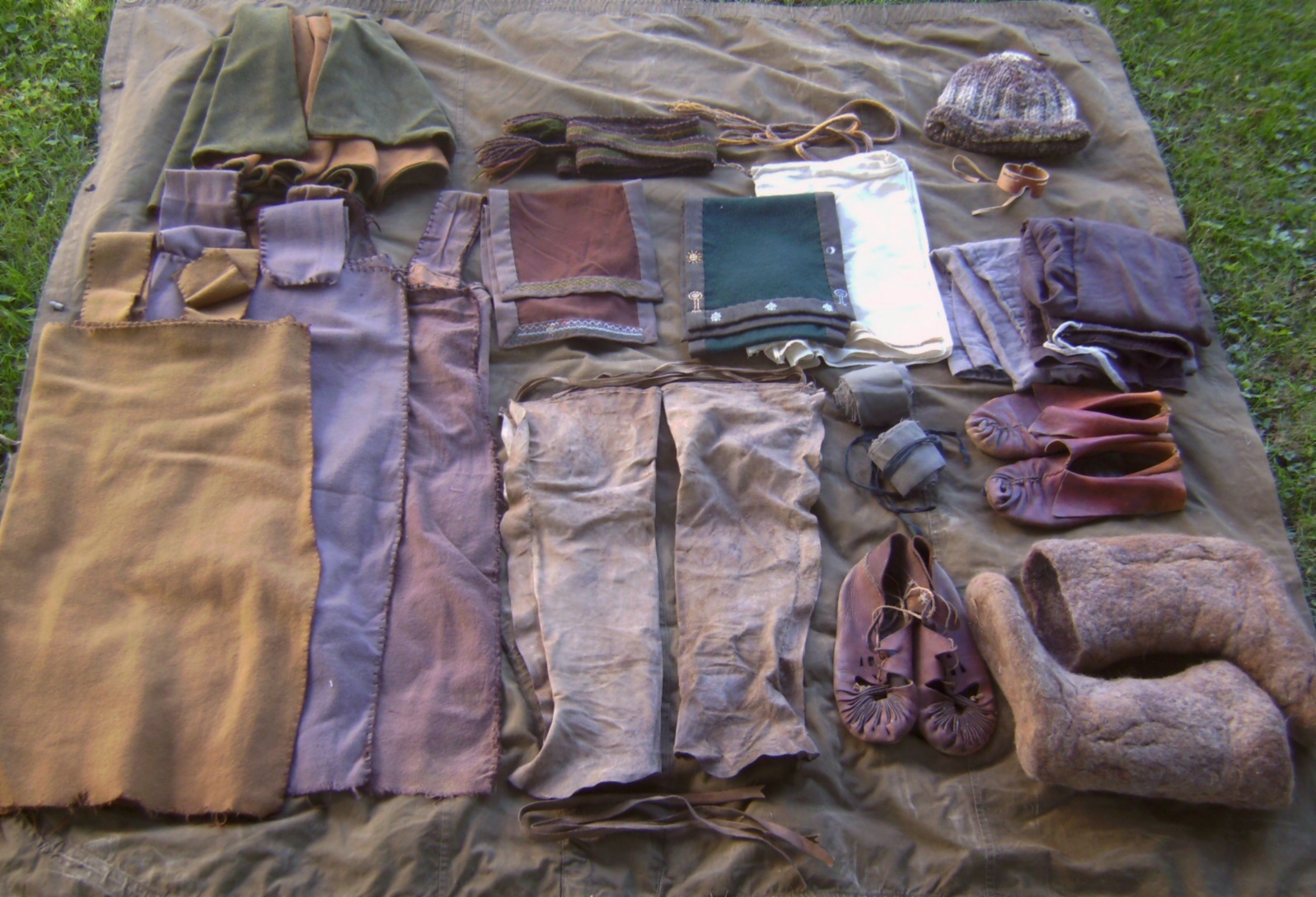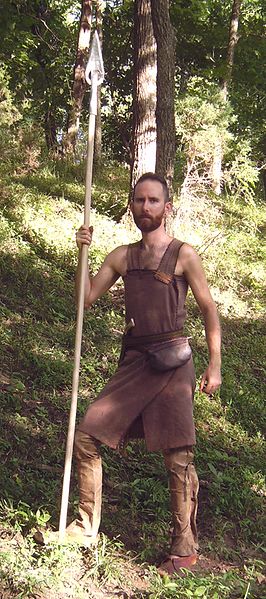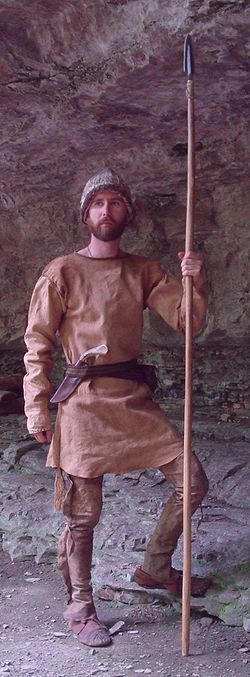Áistan: Soft Kit
My interpretation of clothing in this area is based on the following passages from The Hobbit, Chapter 7: Queer Lodgings:
“Standing near was a huge man with a thick black beard and hair, and great bare arms and legs with knotted muscles. He was clothed in a tunic of wool down to his knees…”
'“Bilbo…could easily have trotted through [Beorn’s] legs without ducking his head to miss the fringe of the man’s brown tunic.”(118).
“…in came some snow-white sheep led by a large coal-black ram. One bore a white cloth embroidered at the edges with figures of animals…” (125).
From these passages, we see that during high Summer, while working outdoors, male dress consists of a knee-length tunic which leaves the arms bare; the “fringe” tells us that the bottom edge is unhemmed and has been allowed to unravel. The material is clearly stated as wool, of which white (therefore dye-able) and black are available colors (Beorn’s brown tunic may also simply be undyed wool of a brown sheep, which in Europe’s Bronze Age seems to have been the only color available).
Basic clothing:
To help decide on the specific pattern of tunic, I first turned to Tolkien’s few vague geographical comments. In Letter No. 294, he suggests that the Shire was “at about the latitude of Oxford”, so by extension the Anduin valley might be said to roughly correspond with northern Germany or Denmark. This is reinforced by linguistics, as names in this area of Middle-earth are drawn from Primary World languages of northern Europe (Gothic and Norse). Therefore, I researched wool garments from northern European prehistory – P.V. Glob’s books The Mound People and The Bog People were very helpful in this. I finally decided on a tunic based on that worn by the man of Emmer-Erfscheidenveen, a bog find in the Netherlands from approximately 1200 BCE.
The pattern is exceedingly simple (only three rectangles), and I was able to make each tunic from a single yard of fabric. The lightweight wool is a period-appropriate plain or tabby weave, and was purchased at $10/yd from the very helpful Hamilton Dry Goods of Tennessee [1].
While no mention is ever made (thank goddess) to his underclothes, it is entirely possible Beorn was wearing his tunic in true ancient European style (without anything underneath!). However, as I prefer to preserve at least some of my modesty on the trail when I meet passerby while trekking, I needed something under my tunic. Enter the simple loincloth or breechclout, which is known in ancient Europe from at least 3500 BCE—Otzi the Iceman wore one made of goatskin. I elected for a woolen ‘clout, however, and was able to find a few suitably long (48”) 100% wool scarves at the thrift store for a few dollars. I used some strips of suiting wool to edge the ‘clout, and embroidered the edges with Middle-earth iconography. The breechclout is held up by a narrow linen belt, which I wove on my inkle loom.
True to Beorn’s style, when working around the homestead I am bare-legged (and often barefooted). However, when I must travel—to the next village over, or into Mirkwood, perhaps—I wear a pair of leggings made of deerskin which I braintanned. These extend about a hand’s width above my knees and attach to the linen belt that holds up my breechclout; similar leggings were also worn by Otzi. While brain-tanned (or buckskin) leather is never mentioned specifically by Tolkien, on two occasions Frodo Baggins is described as wearing a “shirt of soft leather” (FotR 377; RotK 237). Additionally, we know that Thorin’s Company observed “small herds of red deer” —whose hides would be ideal for braintanning—in the lands to the north of Beorn’s house (TH 135). Finally, not only is buckskin indispensable in the wild for turning brambles, briars, and other such prickly vegetation, but it is exactly the kind of 'fabric' a self-reliant woodman would be able to produce from his hunted game.
The only description of footwear worn by anyone from the Mirkwood area is that of Legolas Greenleaf, of whom it is said that “…the Elf had no boots, but wore only light shoes.” (FotR 328). (No mention is made of what kind of footwear (if any) Beorn wore).
In collecting my kit, I had a few options on hand to choose from. First were a pair of one-piece leather shoes I made several years ago, based on a shoe found in a German bog, dated to ~200 BCE.
My other option was a pair of (North American) Eastern Woodland-style puckertoe moccasins made many years ago by a craftsman friend of mine.[2] While these were originally constructed with the leather’s flesh side on the outside (to simulate the de-grained appearance of braintan), when I took them apart this winter to overhaul their soles, I decided to reassemble them with the grain side on the outside, making them look much more ‘European’. Their flaps can be turned up above my ankles and worn with wool winningas (leg-wraps) to keep debris out.
Considerations for cold
In cool weather I wear the same style of tunic as I do in the summer, except in different weights of wool. My spring/autumn tunic is medium-weight grey, and my winter tunic is very thick golden wool—originally a strong yellow which I darkened with several soakings in a tub of black walnut dye.
Since our main visit to Beorn’s house occurs in summer, we do not know what kind of clothing was worn in the Anduin valley in winter. However, even in fairly chill weather (say, high 20s to high 40s °F), wearing a wool tunic and breechclout with buckskin leggings does a good job at keeping me warm (especially if I am active or wrapped in a wool blanket).
While out and about in very cold and windy weather (when windchills go below 0°F), I have found that any exposed skin is quickly sought out, and the one downside to wearing buckskin leggings under my tunic is that my bare thighs are exposed. To remedy this, in such conditions I omit my breechclout and instead wear a pair of linen boxer shorts and knit woolen leggings under my buckskin leggings. This combination does a very good job at both cutting the winter winds and keeping my thighs warm.
With regards to winter, the one obvious downside to my EmmerErfscheidenveen-based tunics is that they are sleeveless!; to remedy this, I wear this buckskin tunic in cold weather, as braintan is perfect for cutting wind and trapping body heat—provided you don’t get it wet!
The tunic is entirely 100% handmade by me—I braintanned the four hides from start to finish and sewed it together with sinews from the same deer. Prehistoric European leather clothing is exceedingly rare in the archeological record, so I had much free rein in designing this garment. While I drew most of its pattern from a medieval kyrtle (without gores), with Tolkien’s mythic prehistory in mind I aimed to design a garment that would be at home anytime from the Upper Paleolithic to the Bronze Age.
I recently found a new use for some old holey wool socks by turning them into mitts, which are perfect for chilly early spring/late autumn. In deep winter, however, I wear a pair of Finnish wool mittens.
To keep my feet warm in cooler months I will wear a pair (sometimes two) of thick wool socks under my leather shoes. I have plans to make a pair of ‘shoepacks’ and wool liners for non-snowy winter wear. In cold and deep snow, my ‘bog shoes’ laced over needle-felted boots* combined with wool winningas keeps my feet dry and warm, even without socks (tested all day with temperatures hovering around 10°F)!
To keep my head warm in cold weather, I wear a natural wool hat knit by my loving mum, inside of which I have sewn a linen liner, to cut biting winter winds.
To keep my head shaded in warm weather (while farming, &c.), I wear a simple woven straw hat. While this may be seen as an anachronism, I feel that it is acceptable. As with my cattail sleeping mat, I submit that utilitarian uses of native plants are attested to in the area, such as Beorn’s bell-shaped straw beehives, and his rush-bottomed chairs (TH 118; 125).
- We do not know exactly when felt was first discovered in our Primary World history, but many felted items date at least to the period which Tolkien attests his Middle-earth occupies (prior to 4,000 BCE). Felt is, I believe, only mentioned once in Tolkien: in the form of Samwise’s “tall, shapeless” ‘hat’ (FotR 78). However, we know Beorn kept sheep, as did the Men of the Anduin (see the Eagle’s comments TH 110). Given the time and level of technology depicted in the region, I do not think it would be out of the question for an Anduin Man to have a few felted garments.


